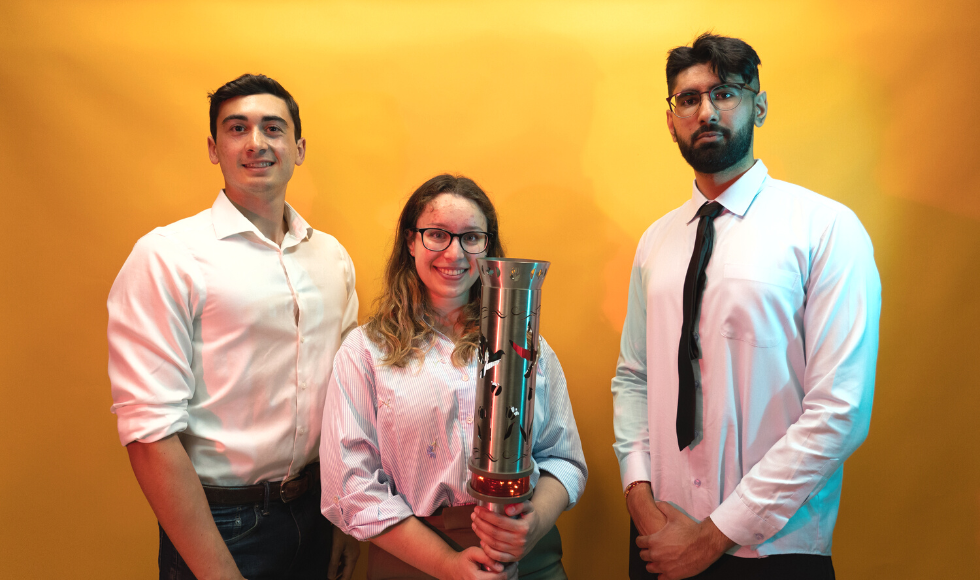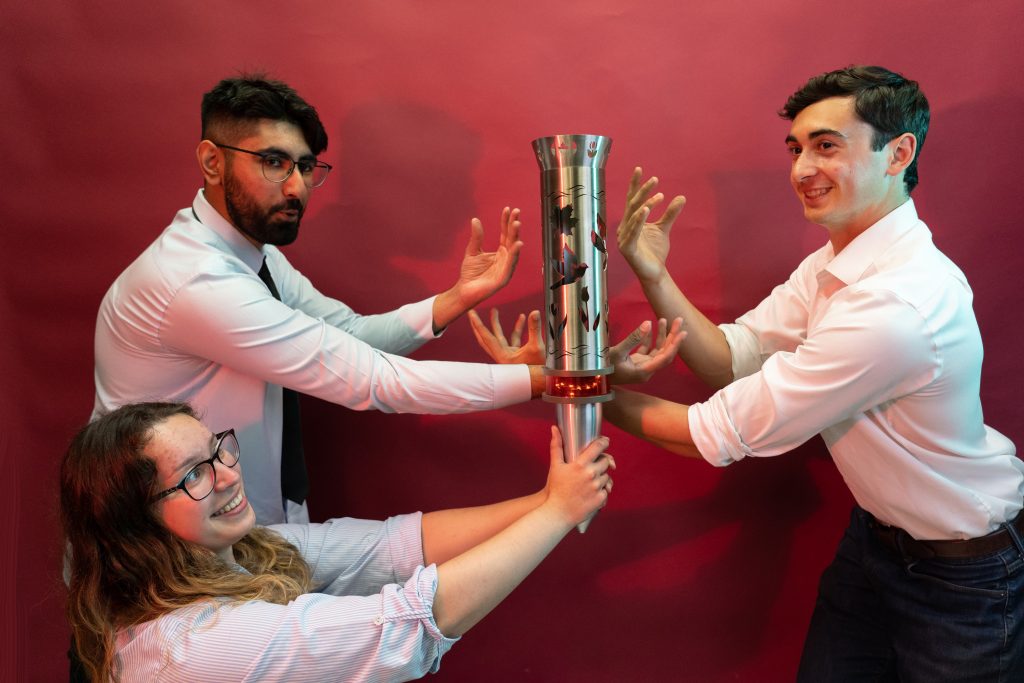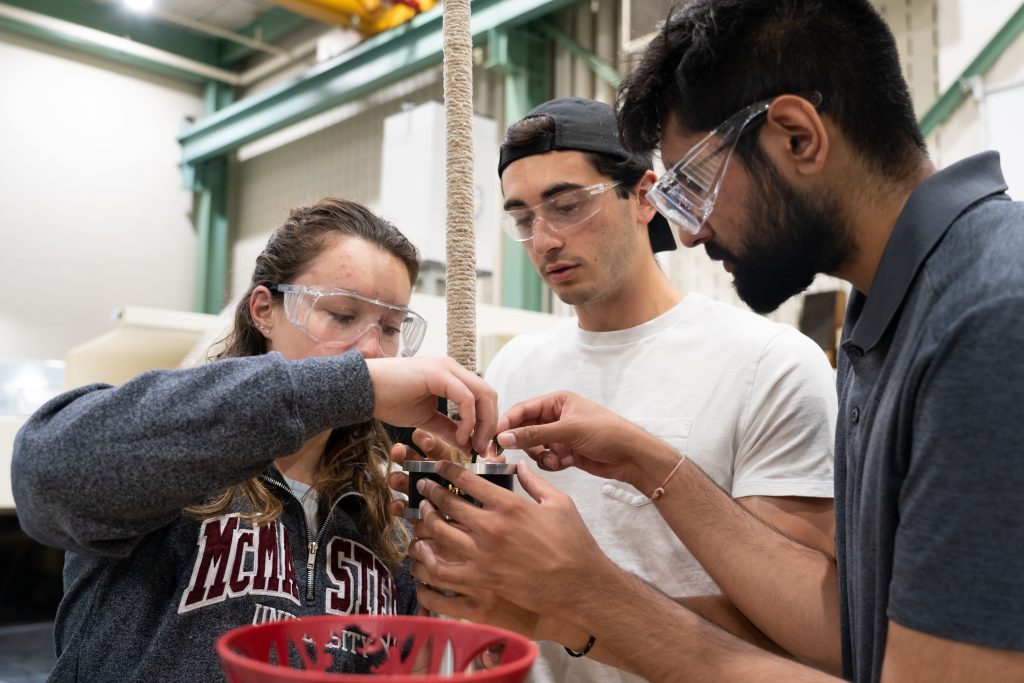Eng students head to Netherlands with special remembrance torch

McMaster Engineering students from left: Sebastian Tattersall, Anna Esposito and Yuvraj Sandhu created the torch to commemorate the Dutch Liberation and honour Canadian troops. They will travel as part of a pilgrimage commemorating the event’s anniversary.
McMaster Engineering students will travel to the Netherlands next month with a special torch created to commemorate the anniversary of the Dutch Liberation and honour Canadian troops.
The students and torch will fly to the Netherlands in September to commemorate the Dutch Liberation’s 75th (plus two, because of COVID-19) anniversary.
After a 60-kilometre trek through the country, a tribute to the Second World War Canadian troops, the specially designed torch will be presented to Princess Margriet in a ceremony at Palace Het Loo in Apeldoorn.
McMaster Engineering designers behind the torch include Anna Esposito, fifth-year mechanical engineering; Sebastian Tattersall, fourth-year mechanical engineering; and Yuvraj Sandhu, third-year computer engineering and management.
Karen Hunter, leader of In Our Fathers’ Footsteps — the non-profit organizing the pilgrimage event — is honouring her own father, a Second World War veteran who was involved in the liberation.
She commissioned the torch and will accompany the students in Ottawa for a send-off by other veterans.
On Sept. 5, the torch will be lit for the very first time from the Centennial Flame on Parliament Hill. The next day, the flame and students will travel to the Netherlands, with the flame contained in a special case.
Esposito, Sandhu and Tattersall answered some of our questions:

What motivated you to take on the project?
Sandhu and Tattersall were both on teams that won the Canadian Remembrance torch challenge, whose goal was to symbolize the promise, “We will never forget.”
“So for this project specifically, when we were going into it, I was thinking: wow, this is an option for me to be as creative as I can. I can actually put all my work out there and have no sort of limitations on what I can achieve,” Sandhu said.
Tattersall recalls learning about the initiative in the class of Stephen Veldhuis, director of the McMaster Manufacturing Research Institute (MMRI), where the students diligently built the torch.
“It sounded like an amazing project. I’ve always been interested in history, specifically World War II history, and so I thought that’s a cool way to apply this through engineering. I also wanted to get more creative design experience and hands-on experience,” he said.
Esposito stumbled into the project by “accident”. She started as a support volunteer for all the student teams in the torch competition, and later joined the team to help more directly with the design.
She laughed and said, “it was definitely a happy accident.”

What was the inspiration for the design?
“Karen Hunter really wanted us to capture the idea of freedom, peace and friendship. The doves are a pretty strong symbol of peace, as well as friendship. The tulips and the maple leaf on the torch also symbolize Holland and Canada. Finally, the waves were added at the top because a lot of significant battles during the Dutch Liberation in World War II happened in and around the water,” Esposito explained.
Sandhu added, “[When the candle is lit], it’s supposed to symbolize the life, the energy, the people that come together and share memories. As the flame goes from the top of the crown downwards, it shows a story like a history. At the end of the torch, the stained glass is supposed to show a unity with ‘We Will Remember’ written in English, Dutch and French.”
What were the obstacles and what were some best memories during the project?
“I think making it functional is the coolest part. It’s often we are only able to design on CAD or just creatively, but it doesn’t go anywhere. However, for this project we’ve had the opportunity to make it very, very real and it gets to travel the world with us. With that, we’ve had to simplify it as much as possible while maintaining the designs,” Tatersall said.
“In general, we had a lot of people pitch in and give us feedback. All of the lab techs were a really, really important part, especially in helping us make a feasible design and doing some of the more intricate operations on the machine, such as the handle, which has a profile. That was a new challenge that we definitely wouldn’t have been able to do without the help of all the techs.”
“With this project, a lot of people put their touch on this torch. I think that’s one of the really cool things and parallels the idea of people collaborating and coming together and creating something through unity.”
What’s the message that you were hoping to convey through the torch?
“From a personal standpoint, I see this as an opportunity to acknowledge and express gratitude for those who lived through the war and fought in the war and were part of that liberation,” Esposito said.
“I also have some personal ties because I have a Dutch background. Having just an acknowledgment of, ‘I see you’, ‘I see the things that you went through’ and ‘I appreciate you’ shows the beauty of the result of the liberation, which is that friendship that’s been fostered between Canada and the Netherlands.”
“We take pride in flying The Canadian Remembrance Torch to the Netherlands in September 2022 to honour the role of the Canadian troops in the Dutch liberation during the country’s belated 75th commemorations. We look forward to helping Canadians celebrate our bond of friendship with the Netherlands that is our veterans’ legacy.”

